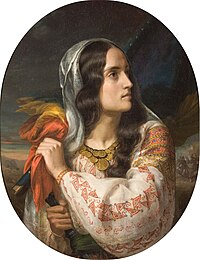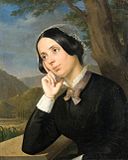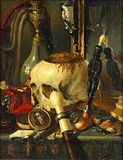Constantin Daniel Rosenthal
Constantin Daniel Rosenthal | |
|---|---|
 Portrait of Rosenthal by Ion Negulici | |
| Born | Rosenthal Konstantin c. 1820 |
| Died | July 22, 1851 |
| Nationality | Austrian, Wallachian |
| Known for | painting |
| Movement | Romanticism |
Constantin Daniel Rosenthal (b. Pest, Austrian Empire: Rosenthal Konstantin, 1820 – July 23, 1851) was an ethnically Romanian painter and sculptor of Austrian-Jewish birth and a 1848 revolutionary, best known for his portraits and his choice of Romanian Romantic nationalist subjects.
Biography
Early career
Born into a
Rosenthal arrived in
Dissatisfied with his oil painting technique, he left for France in late 1844, he attended art courses in Paris, and began attending meetings of Wallachian and Moldavian students who expressed nationalist and radical ideals. He was accompanied by Rosetti, who praised Rosenthal's work ethic:
"There are many Romanians here [but] none of them have to bear the cold Rosenthal has to [in his lodging]. Strange how the noble aim enpowers... there truly are plenty elloquent proofs that the man shall become great!".[1]
This is the most likely date of his multiple portrait, kept only in its
Wallachian revolution
In 1846, the profit from his works afforded him a trip to
Upon the outbreak of the revolution, Rosenthal was spared the first wave of repression ordered by
The Government assigned him the designing of a
Exile

In late September, after
He returned to Pest-Buda, which was still witnessing the
Persecution and killing
Soon without money, Rosenthal left for Switzerland, and lived for a while in late 1850 in the town of Porrentruy, before leaving for Fribourg, then Chur, in the first days of 1851. In Graz until July, where he began receiving some attention from critics,[9] he decided to return to Wallachia in an attempt to rekindle the radical movement.
His plan was divulged by spies of the
In 1878, Maria Rosetti wrote a piece for Mama şi Copilul magazine, in which she praised her deceased friend:
"[Rosenthal was] one of the best and the most loyal people that God created after His image. He died for Romania, for its liberties; he died for his Romanian friends. [...] This friend, this son, this martyr of Romania is an Israelite. His name was Daniel Rosenthal."[12]
Gallery
-
Romania Breaking off Her Chains on the Field of Liberty
-
Portrait of Maria Rosetti
-
Portrait of a woman (1844)
-
Convalescence
-
Anica Manu with her child
-
Portrait of Nicolae Golescu
-
Portrait of Teodor Arion
-
Vanity (1848)
Notes
- ^ Rosetti, in Frunzetti, p.12, in Scurtă istorie..., p.63
- ^ Frunzetti, p.23-24, 31
- ^ Scurtă istorie..., p.65
- ^ Frunzetti, p.17; Scurtă istorie..., p.65
- ^ Rosenthal, in Frunzetti, p.17, in Scurtă istorie..., p.65
- ^ Frunzetti, p.18; Scurtă istorie..., p.66-67
- ^ Frunzetti, p.20
- ^ Frunzetti, p.22
- ^ Frunzetti, p.27
- ^ Accusation rendered in Frunzetti, p.28
- ^ Frunzetti, p.28
- ^ Ion C. Butnaru, The Silent Holocaust: Romania and Its Jews, Praeger/Greenwood, Westport, 1992, p.13
References
- Academia Republicii Populare Romîne, Institutul de Istoria Artei, Scurtă istorie a artelor plastice în R.P.R., II, Secolul XIX, Editura Academiei Republicii Populare Romîne, Bucharest, 1958, p. 61-68
- Neagu Djuvara, Între Orient şi Occident. Ţările române la începutul epocii moderne, Humanitas, Bucharest, 1995, p. 359-360
- Ion Frunzetti, Pictorul revoluţionar C.Rosenthal, Ed. de Stat pentru Literatură şi Artă, Bucharest, 1955








